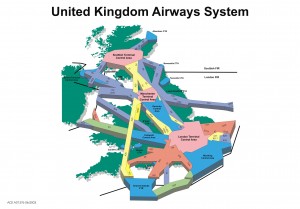Successfully meeting the future demands on UK airspace
Posted: 5 April 2010 | Mark Swan, Director of Airspace Policy, UK CAA | No comments yet
Aviation – facilitated by the effective management of airspace – enables economies to operate more efficiently, enhances people’s opportunity for travel and leisure, and has a key role to play, for the military, in ensuring national security. It is likely that the pressure on the UK’s airspace capacity will continue to grow over the long term. The most recent update to the Department for Transport’s air passenger demand forecasts indicate that overall demand is expected to grow from 228 million passengers passing through UK airports per year in 2005, to 465 million by 2030.
Aviation – facilitated by the effective management of airspace – enables economies to operate more efficiently, enhances people’s opportunity for travel and leisure, and has a key role to play, for the military, in ensuring national security. It is likely that the pressure on the UK’s airspace capacity will continue to grow over the long term. The most recent update to the Department for Transport’s air passenger demand forecasts indicate that overall demand is expected to grow from 228 million passengers passing through UK airports per year in 2005, to 465 million by 20301.
Infrastructure investments have significantly improved road and rail transport and adv ancements in telecommunications have revolutionised the communication ‘space.’ Demand for aviation in the UK, despite the odd blip, has grown continually over the past 60 years and will continue to do so; this thirst for aviation, and all it can deliver, needs a corresponding investment to evolve airspace arrangements to meet demand.
The UK has an excellent aviation safety record, underpinned by high safety standards and the professional dedication of those who use and manage UK airspace. Maintaining, and indeed improving, this record becomes more challenging as the levels of airspace com – plexity increase. The environmental impact of aviation, including greenhouse gas emissions, local air quality impacts and aircraft noise, causes widespread public concern, despite the wide range of mitigation measures in place.
Join us live: Shaping the Next Generation of Hold Baggage and Air Cargo Screening
Join us live for an insightful webinar on 11th December at 14:00 GMT, in collaboration with Smiths Detection, as we explore the strategic balance of operational efficiency, regulatory compliance, and sustainability in high-volume security environments.
This session offers a focused look into future-proofing your security strategy.
Key learning points
- Cost Reduction: Strategies to minimize bag travel time while simultaneously reducing operational costs.
- Regulatory Roadmap: Insights into the next wave of regulatory changes and their impact on future investment decisions.
- Sustainable Systems: Practical approaches to building sustainability into security systems and lowering the total cost of ownership (TCO).
- Scalable Solutions: Real-world examples of scalable systems supporting current airport growth and preparing for tomorrow.
Register now for expert insights, case studies, and actionable strategies on operational efficiency!
While protecting safety is paramount and mitigating the environmental impacts of aviation is high on agendas, creating greater airspace capacity must also balance the requirements of different airspace user groups (airlines, general aviation and the military). It is the interaction between all of these competing factors that provides the impetus to consider how airspace arrangements should evolve over the next 20 years.
The challenge
The CAA has identified four key drivers that if not addressed, could adversely affect the efficiency of our airspace arrangements.
These are:
- The impact of continued growth in demand for aviation, especially in the Commercial Air Transport sector
- The need to mitigate the environmental impact of civil aviation
- The impact of potential future development of UK airports
- The implementation of new technology to manage and control the efficient use of airspace.
Expanding on each in turn:
Demand growth
The predicted growth in demand for airspace capacity may outstrip its availability. Demand for airspace capacity originates from three broad groups:
Commercial Air Transport – although suffering as a result of the current economic slowdown, demand remains high at around 2.3 million2 air transport movements per annum in UK airspace. Growth in demand for air transport is generally related to economic growth, so the number of movements in UK airspace is likely to resume its upward trend in the long term, although the timing and pace of recovery is uncertain. It is not just the level of demand, but also the anticipated geographic dispersal and the mix of traffic that drives the future requirement for airspace capacity.
The Military – need to maintain operational effectiveness through access to appropriately sized and sited airspace in the UK, enabling all arms of the military to ‘train as they would fight.’ Whilst the total numbers of military aircraft may have reduced over time, the performance and training requirements of modern aircraft and weapons systems demand greater volumes of airspace.
General Aviation – serves many purposes including business, leisure and personal transport. It is a diverse sector encompassing business aircraft through to private pilots operating a range of light aircraft including microlights, gliders and balloons. The CAA’s Strategic Review of General Aviation in July 2006 estimated the sector contributed around £1.4bn to the economy in 2005. Overall, general aviation activity is expected to continue to grow out to 2030 and with it the demand for access to uncontrolled airspace. The number of light aircraft on the UK register continues to increase and the number in the ‘microlight’ category has increased even more quickly in recent times. The pattern of demand is also likely to change – there is potential for an increase in the use of Very Light Jets (VLJs), to serve the personal and air taxi market, and unmanned aerial systems (UAS) for both civil and military applications.
The environmental impact of aviation
Aviation’s environmental impact, both locally in terms of noise and air quality and globally in terms of climate change, is a key consideration in the design of airspace arrangements. Initiatives such as the development of more fuel-efficient engines and work on bio-fuels, should serve to mitigate the impact of aviation, as will instruments such as the Emissions Trading Scheme and the introduction of binding targets to reduce CO2 emissions. The need to provide airspace arrangements that have the minimum practicable environmental impact is likely to involve a degree of trade-off to achieve the optional outcomes. In January 2009, the UK Government adopted a target to reduce UK aviation emissions back to 2005 levels by 2050, alongside its decision to support expansion at Heathrow airport. Together with deep cuts in other sectors, this would achieve the UK’s legislated economy-wide greenhouse gas target to reduce emissions by 80% in 2050, relative to 1990, without the need to rely on the purchase of credits in the global carbon market.
UK airport developments
The UK Government’s Future of Air Transport White Paper from 2003, sets out the need to expand the UK’s airport capacity to accommodate forecast growth in demand in a sustainable way. A National Policy Statement (NPS) for airports is expected in 2011. Airport developments cannot be considered in isolation and will need to be matched by corresponding increases in airspace capacity. As such, new infrastructure and airport development will be a key driver in the way our airspace arrangements evolve and expansion plans on the ground will need to accommodate capacity in the air.
In the UK, the Infrastructure Planning Commission (IPC) is a new independent body that will be responsible for considering and making decisions on nationally significant infrastructure planning applications, including airports. The IPC will use the NPS as a foundation for its work and will focus on the ground infrastructure aspects of proposals for airport developments that fall within its remit.
Applications will set out illustrative options for airspace design, but airspace planning and regulatory decisions will remain the res ponsibility of the National Supervisory Authority (the UK CAA). It is axiomatic that airspace decisions are made by aviation specialists and in the context of the whole airspace structure, both nationally and inter nationally. The challenge for the UK is to ensure that the differing demands of round and airspace planning are coordinated, proportionate and synchronised.
New technology
New technology will play a key role in determining how airspace arrangements might evolve. The Single European Sky Air Traffic Management Research (SESAR) programme is a pooling of current research and development efforts, that aims to develop a pan-European ATM system optimising the benefits of new technology. The project is currently in its development phase, which will last from 2014 to 2025, and the UK is actively engaged with, and committed to, this major programme to ensure that the timing and scale of technological changes are matched by changes to the UK’s airspace arrangements. Investment in any new technology needs to be accompanied by clearly identified benefits and a viable safety case, as both airports and airlines will be unwilling to invest unless a return on investment is clearly evidenced. The aim will be to enable a collaborative approach to deliver common benefits across the ATM system, without entailing significant additional up-front investment or undue risk.
Critical factors
In terms of containing the future shape of UK national arrangements and ensuring coherence, there are four fundamental pillars that we ignore, or pay insufficient attention to, at our peril. These are:
- Maintaining and preferably improving the aviation safety record
- Ensuring national security
- Alignment with the European Air Traffic Management vision Compliance with Government policy and the statutory obligations placed on the NSA.
Expanding on these in turn:
Maintaining and improving safety
Safety will not be compromised at any stage as our airspace arrangements develop. All changes must be justified on the grounds that safety will be improved or, at the very least will suffer no deterioration from the current level. The CAA must also comply with the developments in European safety regulation and determine how they are best adopted and enforced at the national level.
National security
National security will not be compromised. Changes to national airspace to deliver additional commercial air transport capacity have to take into account the impact on the military as an airspace user. In the UK, a civil/military joint and integrated approach to airspace design and service delivery has served us well. Military air traffic controllers sit alongside civilian colleagues from NATS at the control centres in Swanwick and Prestwick and they are embedded in the National Airspace Management Cell (AMC), where the pre-tactical and tactical allocation of airspace takes place in line with National priorities and Flexible Use of Airspace (FUA) Policy. Military staff are also seconded to the CAA’s Directorate of Airspace Policy. This approach ensures that the military requirements for airspace are fully considered and integrated with the demands of commercial and general aviation at all levels.
Alignment with the European ATM vision
As in the UK, European airspace arrangements are increasingly stretched. Although the safety record is good, fragmentation of ATC provision is increasingly perceived to cause inefficiency and delays. The European Commission has introduced legislation aimed at creating an airspace system that is planned, managed and regulated in a harmonised way. The Single European Sky (SES) initiative is implementing common rules, that will influence the way our airspace is developed as a central part of the overall European air traffic management network. Taking full account of the relevance and impact of European developments on our ambitions for UK airspace arrangements will be key to success.
National and international policy and regulation
National and international aviation policy and regulation must be strong enough to help drive the implementation of changes, without being overly constraining. To enable effective, timely implementation, any operational and technological changes must be considered in tandem with any policy and regulatory changes required. Policy must be made clear and the associated regulatory processes must be as succinct as possible. The current raft of EU Implementing Rules must be coherent and achievable within plausible timeframes, as well as broad enough to get the job done without being overly constraining; they need to be flexible enough to meet the changing demands from airports and aviation in the round. Similarly, emerging policy on climate change, sustainable development and renewable energy will need to be considered in developing airspace arrangements, due to the potential impacts on aviation.
The need for a Future Airspace Strategy (FAS)
So how to deal with this mix of competing pressures, interest groups, politics and finance? It is immediately clear that changes to the airspace system cannot be considered in isolation. Many desired airspace changes will have a European or international context and even when purely a national issue, they will invariably involve more than one airspace user group. Almost every change will have an environmental, safety, economic and national security dimension to consider, underpinned by emerging technological innovations. Changes to national airspace arrangements are best planned and implemented as part of a structured programme that aligns with airport infrastructure developments, protects safety requirements, acknowledges statutory change and manages the necessary trade-offs in an efficient way. Synchronisation and understanding of investment plans, and priorities of those who have the power to deliver results, would be key to the delivery of optimal arrangements.
The UK’s Future Airspace Strategy (FAS), being developed by the CAA in cooperation with the Department for Transport, Ministry of Defence, NATS and key aviation stake – holders, will seek to address the structured development of our airspace out to 2030. FAS will determine the key characteristics of a proposed airspace system and set out many of the changes required to deliver it, identifying policy and regulatory requirements that support and enable their introduction.
The strategy will determine how best to align with and exploit the operational and technological enablers, coming from external influences like SESAR, and implement them to achieve the greatest potential benefits for the UK. Due to the degree of uncertainty associated with future airspace developments, the strategy must remain flexible. It can therefore be viewed as the development of a framework of options that will assist us in determining how the planning, management and regulation of our airspace should evolve depending on the circumstances. The role played by airports, as the nodal points feeding the airspace structure, will be critical and it will be vital to ensure that they are properly integrated into the network as a whole through a better understanding of their impact on the system.


United Kingdom Airways System
The FAS is being developed as a programme over the next 12 to 18 months. It will allow the CAA to take a more joined-up and proactive approach to the development of our airspace arrangements. These arrangements will need to be integrated with wider Government strategy and balance the needs of different airspace users by understanding and managing trade-offs. The strategy will require further development of the successful FUA concept, to enable even greater dynamic use of military testing and training areas by other users and the provision of tools to enable ‘smart’ airspace allocation to the benefit of all users.
An important factor is the Functional Airspace Block concept (FAB), driven by a performance management approach to service and capability delivery. The intent is for States to reconfigure the upper airspace into blocks based on operational requirements, reflecting the need to ensure more integrated management of airspace regardless of national boundaries. FABs will use the technology provided through SESAR to help address the most challenging and congested pinch points. Due to the size, breadth and complexity of the subject matter, development of the FAS represents a significant undertaking.
The strategy provides a unique opportunity to set the direction for the UK’s airspace arrangements against a backdrop of expected growth in demand for aviation, technological advancement and international collaboration in the sector.
The vision for development of the overall European airspace system is wide-ranging and complex. To ensure optimal outcomes for the UK, the strategy will also need to work with the grain of that vision, anticipating the direction of travel of various initiatives, how they might work together, and the risks and opportunities involved. The overall concept, approach and strategic requirements for UK airspace are set out in a publication entitled ‘Airspace for Tomorrow’, that can be accessed on the CAA website.
References
- UK Air Passenger Demand and CO2 Forecasts Jan 2009, DfT.
- NATS Operational Performance Information
About the author
Mark Swan was appointed as Board Member and Director of Airspace Policy in March 2009. He previously held numerous appointments in the Royal Air Force since joining as a pilot in 1979. Formerly Director of Operational Capability at the Ministry of Defence, 2006 – 08, he is an IoD accredited Chartered Director.
Join our free webinar: Beyond silos: How ecosystem thinking elevates the airport experience
In today’s complex aviation landscape, airports are moving beyond siloed operations to embrace a new era of collaboration. This webinar focuses on how leading airports are using ecosystem thinking to adapt, personalize, and continuously improve every touchpoint, boosting both passenger satisfaction and non-aeronautical revenue.
Date: 13 Nov | Time: 10:00 GMT
REGISTER NOW TO SECURE YOUR SPOT
Can’t attend live? No worries – register to receive the recording post-event.

















